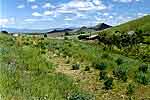Index of articles and links
Even land that has lost all its soil -- or where no soil ever existed -- can be revegetated. Using the method shown, up to a foot of soil can be created in three years, even in arid areas.
Thomas J. Elpel
 Horses breaking up an old road for revegetation. Trampled-in hay and manure creates new soil. Thomas J. Elpel
 New growth colonizing the roadbed. Article on Wildflowers and Weeds website. |
The basic process is simple:
- Seed the area with a suitable seed mix.
- Feed livestock hay on the seeded area. They will eat some of the hay and trample the rest into the ground along with their manure, thus providing food for soil microbes. In drier areas, you need large stock like cattle or horses to stamp seeds and organic matter deeply into the ground.
- Wait for plants to establish.
- Regraze periodically for short periods with high stock density, allowing adequate recovery periods between grazings.
- Monitor the results and adjust your management as needed.
This process can also be used on areas that retain soil but have insufficient forage to feed livestock. Where adequate but undesirable forage exists (such as yellowstar thistle or annual grasses in areas that once supported perennials), well-managed grazing at high density will shift succession toward more desirable species. Examples.
In arid or highly brittle areas where soil life is marginal, avoid all poisons. Herbicide-sprayed "weed free" hay, shed hair from cattle that have been deloused, dung with deworming medications or other biocides, all have enough toxins to kill soil life and delay successful seedling establishment for 3 years or more.
Microscopic soil life creates the conditions for successful germination of perennial seeds. Soil life can be restored by managed grazing and seeding.
Revegetation success stories
Horse hooves stimulate desirable vegetation by Thomas J. Elpel. Methods of using horses on small acreages to revegetate bare ground, restore dormant pastures and stimulate green ones, trample weeds, and assist lawn care. On Wildflowers and Weeds website.
Turning mine waste to grassland created soil up to a foot (300 mm) deep on a site where 60 years of rest had created none. Photos. On the EcoResults! website.
Revegetating a former gold mine on which all other restoration techniques had failed. Photos. On the EcoResults! website.
BLM rents cattle for mine restoration by Peter Donovan. A pioneering experiment by the BLM in Baker County, Oregon. Patterns of Choice, 1999.
Soil-building basics
Improving soil health and building new soil (articles). Soil health is vital to ecosystem health. How to build new topsoil and restore the health of damaged soils using managed grazing. Includes examples of successful soil-building on sites with no soil at all.
Working with soil life (articles). Soil organisms, particularly fungi that help plant roots absorb nutrients, are vital to maintaining soil health and building new soil. The organisms present affect which nutrients are available and which plants can grow and thrive. Soil life can be seeded, its activity measured, and its health promoted by good management.
Related articles and links